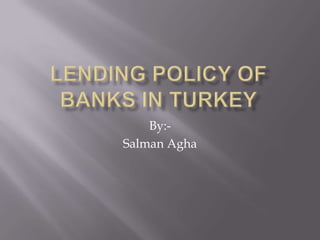
Lending policy of banks in turkey
- 2. "The recent global financial crisis presented substantial challenges and lessons for all economic agents. One of the most important lessons learned was the indispensability of financial stability for the smooth functioning of the economy as a whole. The Central Bank of the Republic of Turkey (CBRT), being aware of the conditions that new global economic conjuncture necessitates, decided to modify its existing framework of inflation targeting by adopting a new policy by using required reserve ratios and interest rate corridor. The new policy mix approach preserves the main objective of achieving and maintaining price stability while safeguarding financial stability as a supporting objective."
- 3. From 2002 to 2005, Turkey implicitly adopted an inflation targeting regime, under which short-term interest rates were used as the main policy tool. Then, in 2006, the central bank switched to explicit inflation targeting. Since late 2010, the Central bank of Turkey has followed one of the most unorthodox monetary policies among emerging markets, relying on a series of required reserve measures, as well as differential exchange rates to attract and retain capital while trying to avoid overheating. In October 2011, the Central Bank of Turkey shifted to an even more unorthodox policy by introducing an interest rate band as its primarily policy tool and providing financing at different rates each week depending on financial conditions. This corridor from 5.75% one-week repo rate and the overnight lending rate (12.5%, then dropped to 11.5%) allowed the CBT to bring effective rates up to over 10% to cool excess liqudity, credit growth and stabilize the lira (indirectly fighting inflation by avoiding imported inflation), without actually increasing the policy rate.
- 4. In the period between November 2010 - when the new policy strategy was introduced - and August 2011, which was marked by escalating uncertainties in the European economy, the monetary policy strategy was shaped around two axes. First, channeling capital inflows towards long-term investments and preventing the over- appreciation of the Turkish lira was targeted. And the second goal was a more controlled growth in domestic loans and domestic demand while rebalancing domestic and external demand. During this period, the interest rate corridor was widened to the south due to the strong risk appetite and intense short-term capital inflows. Hence, overnight interest rates were allowed to occasionally fall below the policy rate so that short term carry trade was discouraged. Also during the same period, reserve requirement ratios were significantly increased with the goal of preventing excessive credit growth and controlling domestic demand. Moreover, foreign exchange buying auctions were held regularly to take advantage of strong capital inflows in reserve build-up.
- 5. These measures made a significant contribution in mitigating excessive appreciation pressures on the Turkish lira. Meanwhile, a notable deceleration was observed in loan growth after mid-2011 owing also to the measures taken by other public authorities, especially those taken by the Banking Regulation and Supervision Agency. As a consequence, the composition of aggregate demand and the quality of capital inflows started to improve, allowing the Turkish economy to follow a rebalancing path as of mid-2011.
- 6. Due to mounting concerns over the global growth outlook and sovereign debt problems in some European economies, as of August 2011, global risk aversion escalated and volatility in risk appetite reached historic highs.6 As capital outflows from developing countries accelerated in this period, the CBRT used the same policy tools but in the opposite direction than during the period of rapid capital inflows. The interest rate corridor was narrowed through raising overnight borrowing rates and Turkish lira reserve requirements were revised to decrease the liquidity requirement of the banking sector. Moreover, a series of liquidity measures were introduced to contain fluctuations in the foreign exchange market.
- 7. However, the rise in inflation was higher than expected due to the excessive depreciation of the Turkish lira stemming from the deterioration of the global risk appetite since August 2011 and adjustments in administered goods prices in the final quarter. In order to contain the adverse effects on the medium-term inflation expectations and outlook, the CBRT raised overnight lending rates in October 2011 and widened the interest rate corridor upwards. Thus, overnight lending rates were permitted to materialize above the policy rate through adjustments to the funding provided to the market. In the meantime, reserve requirement ratios were reduced in order to prevent an undesirable tightening in liquidity conditions driven by the increase in overnight interest rates.
- 8. Accordingly, the measures taken since August 2011 have significantly contributed to alleviate the adverse effects of global problems on the Turkish economy. The CBRT’s measures regarding the foreign exchange market and decisions related to the interest rate corridor in August and October 2011 reduced the degree of fluctuations in the exchange rate compared to that of other emerging market economies. Meanwhile, the monetary tightening implemented since October 2011 has also contributed to moderating the excessive credit growth.
- 9. As was the case in 2011, the CBRT will continue to safeguard the flexibility of the monetary policy in line with changing global conditions, and ensure predictability through effective communication. The monetary policy will continue to contribute to the sustainable growth prospects of the Turkish economy in the context of price stability.
- 10. Thank You
